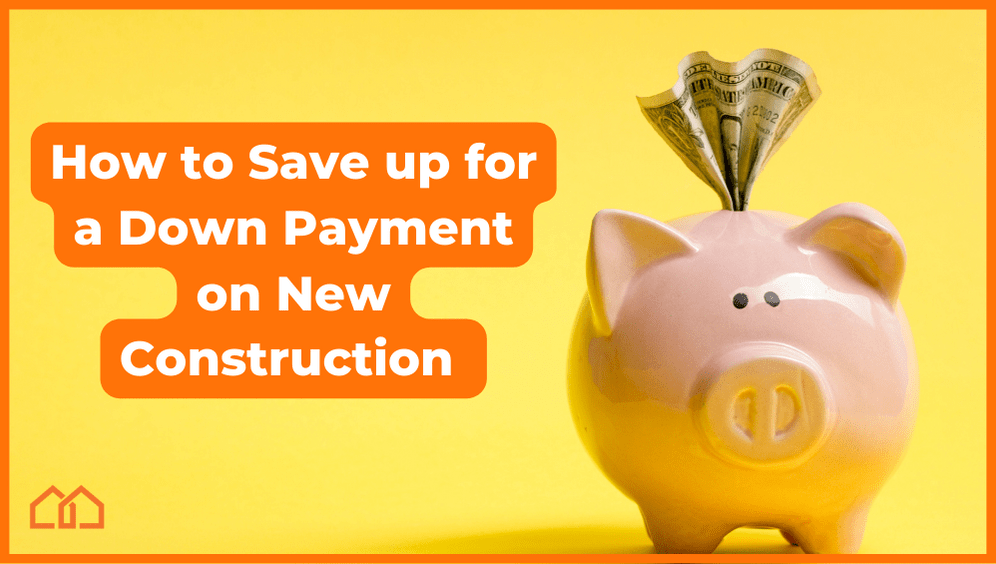You’ve been thinking about buying a new construction home for a while. But saving up for that big down payment seems a bit unreachable. Unlike saving for retirement, you’ll need to save up quite a bit of money that you will need access to in the next few years. The task may seem daunting, and it can be difficult to know where to start. Don’t worry, we’ve got you covered. A new build may require a higher down payment than an existing home, but you can do it! We believe in you. Here’s how you can start saving up for a new construction down payment and buy that new construction home you’ve been dreaming of.
Figure out your financial situation and options.
The first step for how to save for a house is to figure out what your goals are – your timeframe, how big of a house do you want, what’s your budget, how much debt and savings do you have now. If you’re savvy with finances, you can probably do some calculations yourself on an excel spreadsheet and figure out your numbers to get a general idea. However, if you’re not comfortable with numbers, that’s fine!
Find a mortgage lender or a financial advisor, and they will gladly help you figure things out. Whatever your comfort level with finances is, we still recommend that you find a mortgage lender to talk about new construction loan programs. They can give you an official calculation on how much house you can afford, answer questions such as “when is a down payment due for a new construction home?” and also help you understand how much to save for a house down payment if you’re wanting something that’s a little above what you can afford currently.
The general rule is that you want to be able to put down 20% of a home’s sales price. Yes, you can put down less like 15%, 10%, or even less than 10%. 20% is not a requirement. In fact, most first-time homebuyers only put down 6%. The catch is; however, you will likely have to pay more in interest if you put down a lower payment. If you have credit issues, putting a lower down payment may also prevent you from getting that approved mortgage.
Let’s say you want to put down 20% on a $350,000 house. That comes out to be about $70,000. 10% of $350,000 comes out to be $35,000. A pretty significant difference, right? But the thing is, when you factor in the interest rate, you’ll be paying more each month with the lower down payment, and you will very likely have a higher interest rate to start compared to when you put down 20%. In other words, you end up paying more because of interest when you put down a lower down payment on a house.
Did we lose you with all the math yet? We promise we’re done with the math for the rest of the blog. It’s ok if you got lost, as long as you get the general concept, you’re in good shape. When you go to a mortgage lender, they will do all the math for you and explain it in closer detail.

How much of my income should go towards my house?
Someone had an idea one day that the golden rule for mortgage payments was no more than 28% of your pre-tax income. We’re not sure where this rule came from (it probably involved a lot of math), but it works! Before you start running off to calculate how much house you can afford, many other costs are involved with owning a home, such as insurance, property taxes, maintenance, utility bills, and more. Although property taxes may vary and maintenance is low on a new construction home, it’s a little hard to predict precisely how much this will all end up being until you get around to purchasing an actual home.
For now, since you’re in the early phases of saving for a down payment, we recommend doing some basic research into how much property taxes cost in the areas you’re looking for to give yourself a baseline. As for maintenance costs, estimate about 1% of your home’s value on maintenance and upkeep costs every year. (1% of 350,000 = 3500, taking that and dividing it by 12 to get a monthly ballpark of $292). Of course, again, the major perk of buying a new construction home is that you’ll spend very little on maintenance in the beginning. And many of the appliances and features in your home will likely have a warranty that will help you save money if things break unexpectedly early on.
Divide your income into savings.
Time to make room in your income for that house. Saving for a down payment is going to feel a lot more aggressive than saving for your retirement. You’re going to have to save quite a bit of money in a shortened period, unlike your retirement plan which you can save a little every day for almost 40-50 years. Unfortunately, you can’t exactly walk into your boss’s office and ask for a raise on your job the very next day, so you’re going to have to look at your income and see where you can save and eliminate costs.
As much as we all love our vacations, they might have to be off the table for a couple of years until you can reach your goal and purchase a home. You want to cut your budget and put most into savings but make sure your new budget is doable, and you’re not cutting out on necessities (like food!). Cutting down on the times you eat out and get coffee at Starbucks is a great first step, and you’ll be surprised at how much you can save just by eating and making your coffee at home.
Another rule that someone came up with but works great is the 50/30/20 rule. Allocate 50% of your after-tax income to your basic needs (i.e. food, rent, gas, etc.), 30% to wants (Netflix, new TV, Starbucks coffee, etc.), and 20% to savings. We don’t recommend changing the 50% – you do have to eat – but if you have leftover money from your budget, put that towards savings. 30% is the part where you can fudge around with. Maybe you can hold off on buying a new car or getting Starbucks coffee every day until you save up for a house.

Automate your savings.
We’re going to get a little sage-like here and say “out of sight, out of mind.” That’s exactly what happens when you set up an automated saving that pulls a percentage of your paycheck into a savings account. An automated savings process will help you work towards your goal without thinking about it and prevent you from getting tempted to use that money for things you want but don’t need. Start by putting in 20% of your after-tax income into your savings account, and make sure that you also put away any leftover money from your other budgets towards savings instead of spending it on things you don’t need.
Our last piece of advice is to remember that life happens, which means that sometimes your car breaks down or unexpected medical expenses come up. Ensure some of your savings are also going towards an emergency fund that you may need in the future. We’d also like to say that we think it’s totally ok to splurge once in a while as a treat for yourself. Get that juicy, expensive steak, or get that nice pair of shoes for yourself. We support it. The key is not to do that all the time, and when you’re not treating yourself to extra nice things, save that money for your house. Money may feel a little tight for a while, and you’ll need to be adamant about saving up for that down payment. But we promise you, once you get into your dream home, it’ll all be worth it, and you can start saving up for the tropical vacation you’ve been putting off.
Interested in learning more? Let’s talk!
Serena Yan worked as a digital content producer at Marketplace Homes in 2021 and contributed many insightful pieces of content to the MPH blog. During her time at Marketplace Homes, she researched the real estate market, analyzed trends to streamline Marketplace Home’s marketing strategy, and found ways to best engage target audiences. Through writing blogs with topics ranging from market trends to home living, she contributed a lot to the early stages of this blog. Thank you, Serena!

